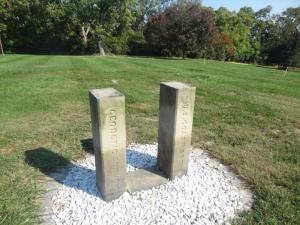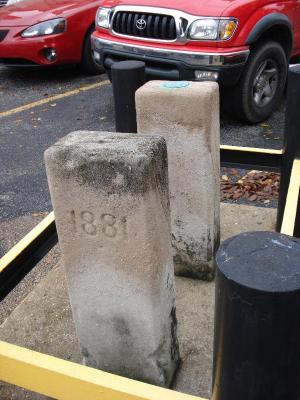Concrete guesses and Delaware 20 goes sky-high

Gate posts for a pasture or field? Property markers? A twin of the last remaining base of the original London Bridge? Vestiges of World War II cement barges research in Lewes-Rehoboth Canal near the Smith property?
Thanks to Margee Turner, Chris Gannon, Wayne Gooch and Bob Bryan (respectively) who all ventured guesses as to the original purpose for the unidentified concrete objects pictured in this column in the Aug. 17 edition of the Cape Gazette. Hazel Brittingham also provided me a photograph of the silent policeman at the corner of Savannah Road and Second Street as another possibility.
Wayne wrote: “Just read your article about the unknown concrete object found near Gills Neck Road. It’s similar to the last remaining base of the original London Bridge. A friend of mine is an official tour guide and showed me London’s hidden gem that looks like what you’ve captured.”
The most complex guess came from Cape Henlopen High School graduate Dave Grosh, who now serves as librarian/archivist for the National Oceanic and Atmospheric Administration’s National Geodetic Survey. “Looking at the pictures of those slabs had me thinking they might be astro stations.”
Astro stations? Don’t be thinking Dave’s gone over the edge. He added more information:
“Astro stations were an extremely important aspect of geodetic surveying until GPS came along. It still survives in the form of some surveyors who may actually perform solar or Polaris (north star) observations to a determined direction (azimuth). Astronomical observations were often used to determine all three primary components of a horizontal system’s latitude, longitude and azimuth. … In the development of large regional systems, such as the North American Datum of 1927 (NAD 27) for the U.S. and Canada, when incorporated into the larger triangulation networks, these stations were important for the determination of what’s called the geoid separation, or the geoid height.”
(I’ll leave it to readers to look up geoid height but suffice it so say it has something to do with establishing specific locations of places not visible from the continental United States, such as islands like Puerto Rico or Hawaii.)
Dave went on to tell me:
“There were only two old astro stations in Delaware and one of them was at Cape Henlopen. It’s described as a brick pier and was very close to the lighthouse. The other station was in Dover. I believe the lighthouse was lost to a storm in ‘26 or thereabouts. This is all a big what if and maybe, but if the lighthouse was taken out, it is not a stretch the astro station was too. It could’ve been found in what is now the state park or around there and wound up in the backyard of Otis Smith. He was mayor and a concrete guy.”
Dave sent along a couple of photos of astro stations which I have included with this column at CapeGazette.com. “There is a resemblance as you will see,” he wrote. “Then again, they could just be two slabs of concrete.”
His explanation puts me in mind of the Transit of Venus Observatory historical marker at the entrance to the Bethel Methodist Cemetery on Savannah Road in Lewes, across the street from Lloyd’s Market. Stop by sometime and read it, and I think you’ll see why.
Delaware 20 goes big
As Butch Emmert predicted, Delaware license tag No. 20 fetched a big price last Sunday during his annual summer auction at Rehoboth Beach Convention Center. Butch knows these rare tags are valuable, but even he was surprised when he hammered the bidding closed at $410,000.
“He’s a retired doctor from Georgetown who lives in Rehoboth Beach,” said Butch. “There were 11 active bidders, but he wasn’t going to be backed off. He came to the auction to buy that tag and he did. He wanted it to stay in Sussex County.”
Emmert said 75 percent of the bidders were from New Castle County, where the tag lived before the auction. The others were from Sussex County. “One guy even called in from France where he was on vacation. I’m glad it stayed here in Sussex.”
The two-digit tag wasn’t the only one that brought big numbers. Emmert said PC33 brought $45,000, a record for a two-digit PC tag. “And Delaware 3200 - that brought $14,000. Most four-digit tags bring $5,000 and $6,000. It was all very strong for the tag market. I’d say everyone who has low-digit tags saw their investments go up by 10 or 20 percent. In 1955, you could have bought Delaware 20 for $5,000. That $410,000 value today is a pretty good increase.”
He said overall, the Aug. 19 auction was a very good sale. “The art sold well; the cars brought good prices. Furniture is still free, but even that’s starting to come back. It’s a reflection of the economy. No question.”
















































